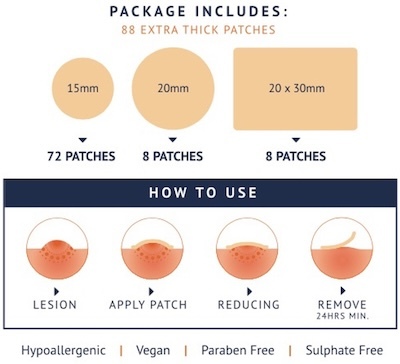Hydrocolloid Patches with Clove: Benefits for Wound Healing, Folliculitis and Molluscum
26th Jun 2025

Hydrocolloid patches are advanced wound dressings designed to maintain a moist, protected environment that supports the body’s natural healing processes. When infused with clove oil, these patches may offer additional antimicrobial and anti-inflammatory benefits. Here’s a detailed look at their roles in wound healing and the management of molluscum contagiosum.
Mollenol Hydrocolloid Patches have both clove and tea tree oil infused.
Benefits for Wound Healing
- Moist Healing Environment: Hydrocolloid dressings absorb exudate and form a gel over the wound, keeping it moist and protected from external contaminants. This environment is known to accelerate healing, reduce pain, and minimize scarring[1][2][3].
- Barrier Against Infection: The outer layer of hydrocolloid patches seals the wound, protecting it from bacteria and other pathogens, which is crucial for preventing secondary infections[1][2][3].
- Reduced Dressing Changes: Hydrocolloid patches can remain in place for several days, minimizing disruption to the wound bed and supporting orderly tissue regeneration[2][3].
- Promotes Tissue Regeneration: These dressings facilitate the formation of new connective tissue and blood vessels, supporting the overall healing process[1][3].
Clove Oil’s Added Benefits:
- Antibacterial and Antifungal Properties: Clove oil (Syzygium aromaticum) contains eugenol and other compounds with strong antimicrobial activity, effective against common wound pathogens like Staphylococcus aureus and Escherichia coli[4].
- Anti-inflammatory and Analgesic Effects: Clove oil reduces inflammation and provides local pain relief, which can further support wound healing and patient comfort[4].
- Enhanced Healing: Studies on clove oil-infused nanofiber mats have shown significant wound-healing potential, with faster closure rates and improved tissue regeneration compared to untreated wounds[4].
Benefits for Molluscum Contagiosum
Molluscum contagiosum is a viral skin infection characterized by dome-shaped bumps that can persist for months. While the infection often resolves on its own, managing lesions is important to prevent spread and secondary infection.
- Absorption of Viral Fluid: Hydrocolloid patches absorb pus and exudate from molluscum lesions, which contain viral particles. This helps contain the virus and reduces the risk of spreading to other parts of the body or to others[5][6][7].
- Physical Barrier: Covering molluscum bumps with hydrocolloid patches prevents accidental scratching and autoinoculation (spreading the virus to new sites), as well as transmission to others[8][7].
- Clean and Moist Environment: By keeping the lesion clean and moist, hydrocolloid patches may support the natural resolution of molluscum and minimize irritation, crusting, and secondary bacterial infection[1][7].
- Clove Oil’s Role: While there is no direct clinical evidence that clove oil cures molluscum contagiosum, its antimicrobial and anti-inflammatory properties may help reduce local inflammation, protect against secondary infection, and support overall skin healing[4][5][7].
Practical Use and Considerations
- When to Use: Hydrocolloid patches with clove are suitable for open, oozing, or irritated molluscum lesions, and for superficial wounds or popped pimples[1][7].
- Application: Clean and dry the area, apply the patch, and replace it every 24–48 hours or when saturated[7].
- Safety: Clove oil is generally recognized as safe for topical use, but should not be ingested or used on large, open wounds. Always monitor for signs of irritation or allergy[4].
Evidence and Limitations
- Wound Healing: There is robust evidence supporting the benefits of hydrocolloid dressings and the wound-healing properties of clove oil-infused materials[1][4][2][3].
- Molluscum Contagiosum: While hydrocolloid patches help manage molluscum by containing exudate and preventing spread, the evidence for active treatment (i.e., faster cure) is limited. Most molluscum lesions resolve naturally, and no single intervention has been shown to be universally effective[9][8][7]. Clove oil’s role is supportive, not curative.
Summary Table: Hydrocolloid Patches with Clove and Tea Tree
|
Benefit |
Wound Healing |
Molluscum Contagiosum |
|
Moist environment |
Yes |
Yes |
|
Barrier to infection |
Yes |
Yes |
|
Absorbs exudate/pus |
Yes |
Yes |
|
Antimicrobial (clove oil) |
Yes |
Possibly reduces secondary infection |
|
Anti-inflammatory (clove oil) |
Yes |
May reduce irritation |
|
Prevents spread |
N/A |
Yes |
|
Supports natural resolution |
Yes |
Yes (by maintaining cleanliness) |
|
Direct cure |
No (supports healing) |
No (supports management) |
In summary:
Mollenol Hydrocolloid Patches with clove and tea tree offer a combination of physical protection, moisture retention, and antimicrobial support, making them beneficial for wound healing and the management of molluscum contagiosum lesions. While they do not directly cure molluscum, they help prevent spread, reduce irritation, and support the natural healing process[1][4][5][7].
- https://www.healthline.com/health/what-is-in-hydrocolloid-bandages
- https://pubmed.ncbi.nlm.nih.gov/8509607/
- https://www.coloplastprofessional.co.uk/advanced-wound-dressings/education-library/hydrocolloid-dressings/what-are-the-benefits-of-hydrocolloid-dressings/
- https://pmc.ncbi.nlm.nih.gov/articles/PMC8123120/
- https://www.mollenol.com/hydrocolloid-patches/
- https://pimple.care/en-us/collections/molluscum-care
- https://www.mollenol.com/q-a/how-to-get-rid-of-molluscum-medical-home-treatments/
- https://www.aad.org/public/diseases/a-z/molluscum-contagiosum-tips
- https://pmc.ncbi.nlm.nih.gov/articles/PMC6481355/
